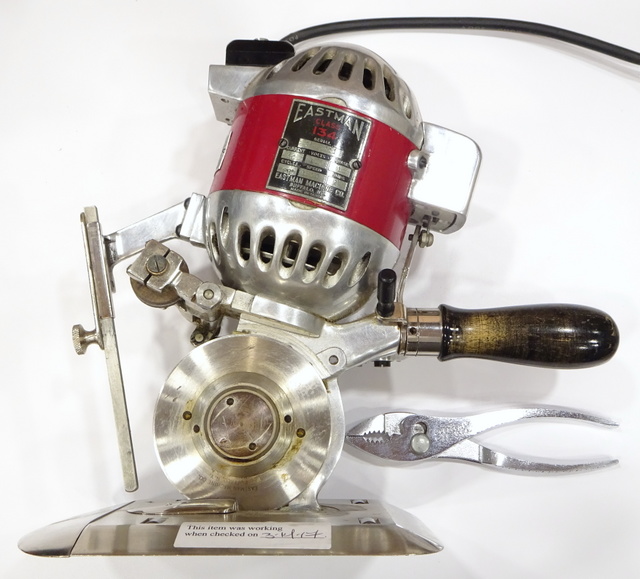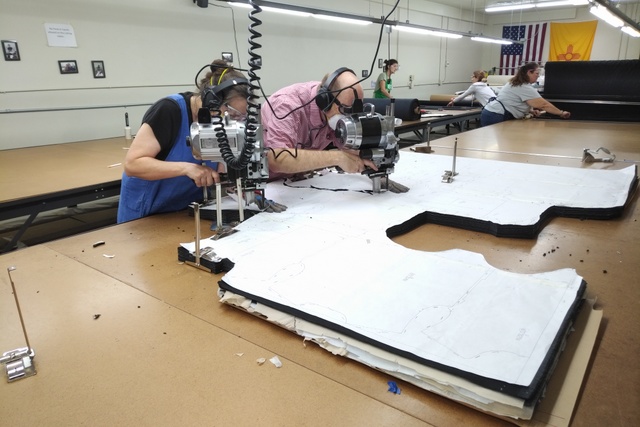I volunteer in the sorting room at my local thrift store about once a week and a few years ago, one of the guys who processes electronics and appliances showed me this thing out on the sales floor and asked whether I knew what it was. Pizza cutter? Linoleum cutter? Don’t know; but it’s a beautiful piece of machinery, so I bought it.
By the time I left the store that night, we’d figured out together that it was a fabric cutter. And as it happens, by now I know a lot more about the topic than I did then.
Kathleen Fasanella and Fashion Incubator
Kathleen Fasanella is a sewn-product industry veteran who has decades of experience and who wrote the book on sewn-product manufacturing. She’s been blogging about the industry since 2005 and gives away a wealth of information on the business, including insightful articles on lean manufacturing written in the context of her industry but applicable to others as well.
Twice a year (except not right now), she conducts a manufacturing boot camp, taking twenty-five participants into her factory for a long holiday weekend and guiding them in cranking out a run of around a hundred of a product to donate to a local charity, starting with raw fabric and ending with a product at a slightly higher price point (that is, a slightly nicer good) than what you’ll see at your local store. This sounds insane and impossible, but it’s not actually … impossible.
I signed up thinking I’d get to see some lean in action (particularly pods) and hoping it would spur ideas I could apply in my IT work, the way The Phoenix Project adapts the lessons and storytelling style of The Goal from physical manufacturing to the software development lifecycle. I’ve returned to and volunteered at her boot camp because of the great group of people getting together with enthusiasm and energy to learn and to make something that benefits society.
Industry Fabric Cutting
In the sewn-product industry, fabric for mass-produced goods is generally cut the same way regardless of whether it’s for garments, messenger bags, or tents. (The primary exception is heavy goods like felt and leather, which are press-cut with a die.) (If you’re an industry expert and take such exception to my generalization that you feel compelled to comment about it, be sure to include why the failures of my generalization are relevant to the topic I’m discussing here.)
A custom cutting guide called a marker is drafted (probably in CAD) and printed to lay on top of the fabric. The marker contains the pattern for all of the pieces of all of the sizes to be cut from that type of fabric, packed as closely together as possible to reduce waste, hence cost. In fact, the marker typically contains multiple iterations of each size, because no matter how well you pack the pieces, most markers will end up with a somewhat jagged end; and the unused fabric at that jagged end is waste. The higher the count you put into a single marker and the longer it gets, the more repetitions you have (multiplied) before that jagged end of waste (constant) and the higher the overall yield. Kathleen reports that her two 6′ x 80′ cutting tables are mid-sized for industry.
You unroll the fabric onto the cutting table, getting it perfectly straight and aligned, stacked in as many plies as you need for your production run, up to many inches thick. You then put the marker on top and cut with an electric knife, like this:
On this very small production batch for boot camp, that’s Kathleen and Mr. Fashion-Incubator all safety-ed up to run the knives, which oscillate a 10″-long razor blade up and down at something like 3000 cycles per minute, IIRC. Just stop and ponder that for a bit.
The knives are great; but watching them in operation, it’s easy to tell how much skill and experience they take to use. With the pieces packed tightly together, go a little past then end of a cut and you’ve nicked the next piece. You may have to trim a tiny sliver off an edge because two slightly differing curves were packed side by side and you can’t cut both at the same time. The stack has some give and you want it to remain perfectly vertical so all the pieces in the stack are identical.
But in exchange for the skill and safety considerations, you get a huge yield, fast.
My older cutter at the top is a slitting machine, apparently for making long cuts to take fabric down to a narrower width. You can tell by the blade shape that it wouldn’t navigate curves and corners well.

